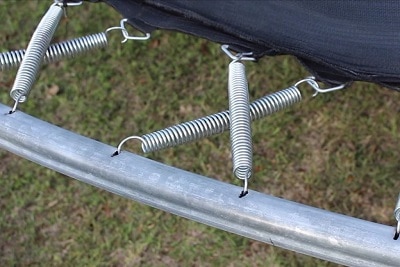Spring and mat are two main things that make it bouncy. But, trampolines may lose their bouncing power over time. So, why do trampolines lose their bounce? It may happen due to structural damage or incorrect setup.
However, you can get back the jumping capacity. So, how to make your trampoline bouncier? Removing rusty or damaged springs, installing powerful springs, crossing the springs, etc, are some of the proven ways to make the trampoline more bouncy.
This article will guide you to regain the trampoline’s bouncing power. Let’s reveal the tips to make the trampoline super bouncy.
Why is My Trampoline Not Bouncy?
There are several things for which trampolines may lessen their bounce over time. Before you hop on making the trampoline bouncier, it’s important to figure out the exact reason that decreases your trampoline’s bouncing capacity and take action according to this.
Here are some common reasons behind losing your trampoline’s bouncing power.

i. Rusty Springs
Rust is a major threat to reducing the trampoline’s bouncing capacity. Although most trampolines use rust-resistant galvanized springs, still, rust will form there over time as they are exposed to harsh weather.
Rusty springs may get stuck when you are on the trampoline; thus, you mightn’t get the proper bounce.
ii. Missing Springs
Is there any spring missing from the trampoline? Check it out, this might be a prime reason to reduce trampoline bounce.
iii. Broken Springs
If you overweigh the trampoline or anything falls suddenly on the jumping bed, there is a high chance of breaking or damaging the springs. And you don’t get high bouncing in such faulty springs.
iv. Damaged Jumping Mat
A trampoline mat might be worn for several reasons. For example, sharp objects or cigarettes may create holes there. And you don’t get the right bounce from the wear and tear mat. Exceeding the weight limit might be a reason for this.
v. Wrong Setup
This is another major reason why trampolines don’t perform well. It includes the wrong placement of the mat or springs. Another cause might be the incorrect springs or mat size. Moreover, it may happen when the base shakes due to not leveling the ground properly.
vi. Overstretched Elasticity
When you use a trampoline for a longer period, both springs and mat get stretched and lose their elasticity. The weak elasticity mat and springs don’t provide the desired bounce.
vii. Exceeding Weight Limit
Like all other structures, trampolines have their own weight capacity. When you exceed the limit, it might weaken the structure, hence reducing the elasticity of the trampoline as well as the bouncing power.
What Makes A Trampoline More Bouncy?
If you’re still confused, can you make the trampoline bouncier, actually? Yes, there are several ways to make a trampoline more bouncy.
The main things that make trampoline high bouncing are good quality springs and heavy-duty trampoline mats. The following section will guide you to do that in the right way.
How to Make Your Trampoline Bouncier?
Here, I’ll cover the eight most effective methods by which you can increase the trampoline’s bounce capacity.

Method 1: Regular Checkup is Important
The first thing that I suggest you can do is to check up daily or routine-wise to be sure everything on the trampoline is running well. This will help you find out the faulty springs or holes in the mat. It will allow repairing the trampoline at a cheap cost. This is because prevention is better than cure.
So, if you find any faulty springs or tears in the mat, take immediate action to solve the problem. For rusty springs, you can use rust prevention spray or homemade lemon solution. Also, the worn mat should be patched well. This will extend the trampoline’s lifespan as well as help you enjoy good bounce.
Method 2: Replace Rusty and Faulty Springs
Damaged or rusty springs don’t provide the expected bounce, and they might be prone to injury. When you jump on the same springs for long periods, springs lose their elasticity. So, it’s recommended to replace the rusty, overstretched, or broken springs soon to regain elasticity.
First, mark the rusty or faulty springs. Then, measure the spring’s size, and purchase the springs you need to replace and install them. Hopefully, this will improve the bouncing quality of your trampoline.
Method 3: Attach Additional Springs
This is not just changing the defective springs; it also includes adding more springs to the trampoline. More springs will ensure better bouncing. Depending on how much bounce we want, add the necessary number of springs.
You can connect two, three, or more springs in each slot, but this might lessen the springs’ life. So, it’s important to balance between the bounce and spring life.
Method 4: Use Powerful Springs
Another effective way to make the trampoline more bouncy is to install strong springs that will bounce you higher. Powerful springs come in better thicknesses and longer sizes.
Heavy-duty springs store more energy as well as exert high energy (bounce) when you bounce on the trampoline. So, attach strong springs with the trampoline to get the utmost bounce.
So, we recommend you attach powerful springs soon if you want to get a high bounce. Strong springs will cost some penny, but they are worth the fun!
Here is a recommended powerful trampoline spring to make your trampoline bouncier.
Read Also: Trampoline spring squeaking solution
Method 5: Crossing the Springs
If you actually want to make your trampoline bouncier, you can buy some new springs and install them with the trampoline in some specific patterns to get the highest bounce. Usually, one end of the spring is attached with v-rings of the mat and another one with frame slot positioning straight to the V-rings that make I-shape.
But in crossing, springs are connected in different ways, including X, V, W, and more patterns. Let’s know, how to cross springs on a trampoline to make it heavy bouncing.

5.1 X-Pattern Springs
This is a comparatively easier process than other spring crossing methods. It allows doing spring crossings without buying new ones. For making a criss-cross X-pattern, remove two consecutive springs and array them to get an X-shape.
So, attach the first end of the two springs with V-rings of the mat, then attach the other end at the alternate slot of the frame (2nd slot for the first spring and 1st slot for the second spring). Make sure the springs arrangement forms an X-shape.
This type of criss-cross spring attachment increases trampoline bounce profoundly. And the more places you do it, the bouncier the trampoline will be.
5.2 Double X-Pattern Springs
Like X-pattern, you can also do a ‘double X’ crossing the springs for further bounce. In this method, consider four springs, four v-rings, and four frame slots to make a double X.
In this spring attachment, you will get a higher bounce than the X pattern due to the use of double springs instead of one.
5.3 V-Pattern Springs
The process doesn’t also require purchasing springs, moreover, it frees up some springs. To array springs in a V-pattern, consider two springs and three frame slots, and three V-rings of the mat.
Attach one end of both springs in the middle rung of the frame. Then, attach another end of them with the 1st and 3rd V-rings of the mat respectively to form a V-shape. And this will continue for the complete trampoline spring arrangement.
This method will engage one slot, and the alternate slot will be freed. Although this type of crossing makes the trampoline more bouncy. Still, the chance of decaying the jumping surface will rise a bit. The total array will seem to be V or W shape, right?
Read Also: Different among different shapes of trampolines
5.4 Complex W-Pattern Springs
If you need further bounce than the X and V pattern spring crossing, it’s recommended to apply the W pattern. To do this, you may need to purchase some new springs but definitely get a higher bounce, I bet!
This actually combines the W, and I pattern. The smallest cell of the pattern consists of four springs with five frame rungs and five V-rings of the mat. Connect one end of the spring in the 1 and 3 V-rings and another end in the second rung of the frame. This will actually form a V-shape.
After that, create another V-shape spring pattern between the space of 3 to 5 V-rings of the mat. So, the double V forms a W-shape, right? Now, attach another spring in the third slot of the mat with the third slot of the frame. Thus, the complex W-pattern crossing is created.
Follow the pattern for the whole trampoline spring arrangement to get the highest bounce on the trampoline.
5.5 Zigzag Pattern
In general, the more springs you use in the trampoline in a pattern the more bounce you’ll get in general. So, if you need more, more, and more bounce you can attach the springs in a zigzag pattern combining the I, X, V, and W pattern.
But, I don’t recommend doing this in general as the friction among springs might decrease the bounce and lessen the springs’ life.
This video explains different types of springs crossing to make the trampoline bouncier.
Method 6: Use Double Layer Spring Trampoline
If you are looking for an alternative way of making a trampoline bouncier without crossing the springs, a double-spring trampoline would be the right option. The following section will give you an in-depth idea.
Double layers of springs are nowadays seen on some specially designed trampolines. One layer of the spring array is connected with the outer jumping layer, and the other one is attached under the first layer lying a few inches under the outer layer.
This type of double-layer spring provides high bouncing than the usual trampoline. When you jump on the trampoline, you hit the upper mat. Thus, it goes down and then hits the second mat. So the springs of two additional layers push you higher. That’s impressive!
So, if you want to get to know how to make your trampoline bouncier without crossing the springs, it’s recommended to get the double springs trampoline to jump higher without making any changes to your existing trampoline.
Read Also: Double bounce trampoline
Method 7: Make In-Ground Trampoline Bouncier
How to make in-ground trampolines bouncier? In-ground trampolines aren’t as bouncy as regular trampolines. However, it’s recommended to follow some tips to get a higher bounce from sunken trampolines.
For example, install the trampoline a few inches above the ground so air passes well. This will help to get a high and comfortable bounce.
Method 8: Replace Trampoline Mat
If the trampoline mat gets damaged or shows any tear and wear, you need to replace it soon to get back the bounce. Prolonged use may lose the elasticity in the mat or creates a hole there.
So, whenever you see any rip in trampoline mat, don’t delay to replace or repair the mat. The new mat will give a new life to your trampoline.
Read Also: Is it good to jump on a chilly trampoline?
Why is My New Trampoline Not Bouncy and How to Fix This?
If you see your newly purchased trampoline is not so bouncy, you will be very anxious, right? This might happen for several reasons. Here I’m discussing the causes with solutions.
Trampoline Might Be Too Big for You
If the trampoline is too big, you mightn’t get the proper bounce. So, you should get the right size trampoline for maximum bounce. If you purchase a trampoline for kids and they aren’t getting a good bounce there, then do a quick check.
Get a heavier jumper to jump on the trampoline if he/she gets good bouncing, but kids can’t; this trampoline is too big and not the right choice for kids.
In this case, swap a good size with a neighbor or purchase a new one that fits for kids. The best practice is to research well before you purchase first.
Read Also: Different Kinds of trampolines
Check If There is Any Missing Spring
Missing spring is another common reason why your trampoline isn’t bouncy. So, have a quick check and install springs in the missing places.
Springs aren’t Right for You
If you are very heavy, small springs won’t give you the right bouncing fun. Similarly, too-big springs aren’t good for lighter people.
Incorrect Setup
Another reason could be either placing the trampoline in the wrong place or assembling the parts incorrectly.
See Also: Best things to put under the trampoline
Tools and Accessories Require to Make Trampoline Bouncier
Here is a list of stuff you might need to make the trampoline bouncier.
Springs
Consider how many springs you need to replace or add new ones to increase the trampoline’s bounce.
Spring Puller
Trampoline spring tool is used to assemble and remove the springs quickly. Alternatively, you can use a spanner, screwdriver, power drill, pliers, etc.
Trampoline Mat
When the trampoline mat is worn, you need to change it fast to get a proper bounce. In this case, buy a new high-performing mat. It’s recommended to purchase polypropylene or Permatron mat for the trampoline.
Rust Removal Spray
If you want to remove rust from the trampoline, a rust removal spray will be a great option. You can also make it at home using the lemon solution.
Rubber Mallet
This might be necessary sometimes to position the springs in the right place.
Gloves
They are used for hand safety during spring attachment and removal.
Safety Factors to Consider While Making Trampolines More Bouncy
Safety Net
A high-bounce trampoline will push you higher; thus, the chance of falling off the ground increases a lot. So, install a safety net with a trampoline to prevent such accidental falling and getting injured. And choose a good height enclosure net in this case.
Spring Pad
Make sure the spring of the trampoline is covered by a spring pad. This will reduce the impact of falling over the springs and frame.
Frequently Asked Questions
1. Does a wet trampoline make it bouncier?
Ans: Yes, water makes a trampoline a little bouncier. The weight of water weighs the trampoline mat down and loosens the springs which makes the trampoline more elastic thus providing a higher bounce than normal time. This might happen due to the result of the evaporation of water.
Read Also: Can you jump on wet a trampoline in winter?
2. Is it ok to jump on a wet trampoline?
Ans: Although the damp mat is a little bouncier, still small kids should avoid this for safety. But adults and teenagers will enjoy bouncing on the slippery surface. However, before you jump on the trampoline, dry it well using a towel.
3. Is spring crossing ruin the trampoline?
Ans: Spring crossing is good for creating a high bounce on the trampoline. But, due to friction among springs, it might lessen spring’s lifespan.
4. Do trampolines get bouncier over time?
Ans: When you install a new trampoline, it mightn’t provide the best bounce. But, after jumping several days, it’ll give the utmost bounce. And afterward trampolines start to lose their bouncing capacity over the time.
Final Thoughts
Who doesn’t love jumping higher on a trampoline? When it loses the bouncing power, you can get it back in several ways, such as crossing the springs, using powerful springs, using double springs trampoline, and many more.
Also, take proper care of your trampoline and repair the springs and mat when necessary to hold the bouncing power. And when jumping on the bouncy trampoline, consider a spring pad and surrounding net for safety.

Robert is a trampoline and rebounder trainer with a passion for blogging. He discovered his love for trampolining at a young age, when his father gifted him his first trampoline at the age of 9. Over the years, Robert has honed his skills and knowledge in the field, and now uses his expertise to train others.
Besides, helping fitness enthusiasts in the gym, Robert is very eager to share his knowledge and experience regarding trampolines and rebounder exercises with the readers of picktrampoline.com. He will share all you need to know about trampolines and rebounders in this blog. Get his tips on trampoline and rebounder!
